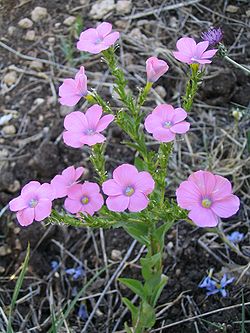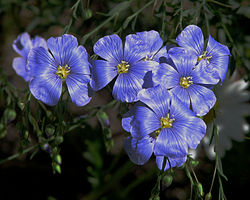| Linum | |
|---|---|
 | |
| Linum pubescens | |
| Scientific classification | |
| Kingdom: | Plantae |
| Clade: | Tracheophytes |
| Clade: | Angiosperms |
| Clade: | Eudicots |
| Clade: | Rosids |
| Order: | Malpighiales |
| Family: | Linaceae |
| Subfamily: | Linoideae |
| Genus: | Linum L. |
| Species | |
about 200, see text | |
Linum (flax) is a genus of approximately 200 species [1] [2] in the flowering plant family Linaceae. They are native to temperate and subtropical regions of the world. The genus includes the common flax (L. usitatissimum), the bast fibre of which is used to produce linen and the seeds to produce linseed oil.
Contents

The flowers of most species are blue or yellow, rarely red, white, or pink, and some are heterostylous. There is an average of 6 to 10 seeds per boll.
Linum species are used as food plants by the larvae of some Lepidoptera species including the cabbage moth, the nutmeg, the setaceous Hebrew character and Coleophora striolatella , which feeds exclusively on Linum narbonense .
